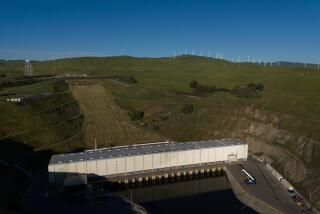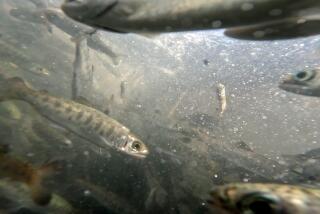Home wreckers
- Share via
In shallow water along the west shore of Lake Casitas, beside branches covered with shaggy moss, lies a fish “nest,” made not of twigs and feathers but scraped into a plate-size depression of gravel and clam shells.
A male largemouth bass made it with his tail and nose and hopes to entice the big females lurking nearby to spawn. Bass do this every spring. Yet, intimacy leads to vulnerability, and it is this moment that anglers such as Eric Elshere wait for all year.
An aspiring tournament pro and lake regular, the slender 20-year-old maneuvers his silvery black boat like a shark closing in. The nest is a bull’s-eye on the bottom.
Elshere tosses a white jig. The male bass lunges but misses. He casts a floppy rubber trout onto the nest, the plump female charges the lure but stops short. On the next cast, she tears it in half, and on the third try Elshere swings back to set the hook, then reels in the 10-pounder, a basketball with fins, which he’ll later release.
Birds, bees and the fish all have something in common this time of year. They’re in the mood for love, doing what comes naturally -- which for bass means mating in coves and on flats in lakes and ponds across the nation’s Sunbelt. In lunker-rich Southern California, bassers arrive in droves, hauling boats to such reservoirs as Casitas, Dixon and Perris. They come to “sight-fish,” targeting bass visible in shallow water. During this narrow window of opportunity -- bass remain on nests for just a few weeks, long enough to hatch and disperse their offspring before moving back into the depths -- the fishing is up close and personal.
“This time of year is really, really special because a guy has a chance of catching the biggest bass of his life,” says Bobby Barrack, a Bay Area guide in the delta city of Oakley.
But some fishermen refuse to play the game. They think it’s unsportsmanlike. Others say it’s harmful. Coitus interruptus, critics charge, cannot be good for Micropterus salmoides.
Spring means longer days and more sunshine. Water warms. When surface temperature reaches 60, largemouth bass get active and move into areas 10 feet deep or shallower.
Males cease feeding and start building nests while females, bulging with eggs, wait nearby. The female will eventually join the male and they’ll swim in circles, side by side. Both will tremble as they release eggs and sperm simultaneously on the nest.
The male then guards the eggs until they hatch, usually in two to four days, and he protects the fry for up to two weeks. Less than 1% of the eggs survive as sunfish and other aquatic creatures are relentless in their feeding attacks.
*
Angler’s advantage
For some, targeting bass during this precarious moment seems unethical. As if bed-fishing, as it’s also called, didn’t give anglers advantage enough, new technologies make the spring harvest even more lopsided. Some lower waterproof cameras onto the nests, back the boat away and watch a TV screen so they can set the hook the instant the bass attacks the lure.
“Anglers these days are so many and so efficient, perhaps we shouldn’t be hanging our hats on old principles anymore,” says Charles Berry, a fisheries biologist at South Dakota State University. “I suppose there could come a time when anglers begin to overwhelm Mother Nature’s laws.”
Nevertheless, most lakes allow bass fishing during the spawn, and business booms at marinas, tackle shops and restaurants. Many biologists don’t oppose the practice either, saying that as long as most of the bass are released, enough spawning will occur to keep the fisheries healthy.
“There have been several studies that have concluded that sight fishing doesn’t have an effect on [bass] populations,” says Mike Giusti, a state Department of Fish and Game biologist in charge of Diamond Valley Lake in Hemet. “Do fishermen find all of the nests? No. Do they find one-tenth? Probably not, but maybe.”
Santa Paula’s Rod and Todd Thigpin, makers of the Stocker Trout lure, regularly post big catches at Lake Casitas and are the envy of other anglers. But they’re averse to bed-fishing. “I’d hate to catch a big fish like that. Even if you don’t catch it, you’re moving it off the bed,” Todd says. “It’s just something we choose not to do.”
At Casitas, just north of Ventura, a montage of new and yellowed Polaroids of humongous bass -- the lake record is a 21.19-pound largemouth nabbed during the spawning season of 1980 -- adorns the walls and countertop of the tackle shop.
Cigar-chomping Randy King, 55, has been behind the counter for 37 years and has seen plenty of big fish come out of the lake. He says fishing is tough nowadays and that bed-fishing is at least partly to blame. During tournaments, 100 anglers per day are “ripping” fish from nests and releasing them up to two miles away in the marina after they’re weighed, he says.
“The fish aren’t going to move two miles back to their nests,” King says. “It bothers me, and I don’t like seeing it.”
One study conducted two years ago by Mark S. Ridgway of the Ontario Ministry of Natural Resources in Canada involved 19 tagged bass and found that it took more than two weeks for fish to travel only 1,200 yards from the release site. The overall rate of return to the capture site was 37% (seven fish), with three fish taking a year to get back.
Another study shows that bass suffer exhaustion and may lack energy to adequately protect the nest. Published four years ago in the North American Journal of Fisheries Management, the study also concluded that “catch-and-release angling during the parental care period may lead to predation and premature nest abandonment.”
*
‘An egg machine’
But the majority of scientists do not believe bed-fishing is detrimental to overall bass populations.
A big female bass, Giusti says, is an egg machine. She can lay more than 10,000 eggs on a nest and will generally spawn more than once. To make his point, he cites the recently opened Diamond Valley Lake near Hemet. “We have 45,000 fish capable of reproducing now,” he says. “You figure out the numbers.” Others argue that high-performance boats, sonar equipment and graphite fishing rods are no match for the cagey bass, and most spawners are never discovered, much less caught.
Meanwhile, portions of Lake Casitas and most other reservoirs are closed to fishing, giving bass a safe haven in which to reproduce, and an electro-fishing survey conducted last summer at Casitas revealed a prolific and long-lasting spawning season, according to the Fish and Game department. Some lakes in the Midwest and South used to close for spawning season, but don’t anymore.
Carol Martens of West Hills, a bass pro and mother of Aaron Martens, one of the country’s top anglers, says she bed-fishes only for males and won’t bring them onto her boat. But she wouldn’t want to stop altogether.
“People like me have a blast sight fishing.... A spunky male will see me there and we’ll play our little games. It’ll sometimes take two hours to prove who’s boss. It’s not easy, but I’ve caught the same fish as many as three times.”
*
Catch of a lifetime
For Elshere, who lives in Ojai, just a few miles from Casitas, bed-fishing is about finding a monster bass that could launch his pro career or hook him up with a record fish likely worth millions of dollars in promotions.
After boating the 10-pound female that fell for the rubber trout, he used the same technique to pluck an 8-pounder and a 6-pound fish from nests.
A day later, controlling the boat from its bow and wearing Polarized sunglasses to penetrate the glare, he found a secluded bank and within minutes located a nest being guarded by a 3-pound male. He flipped the white jig and reeled it onto the bed. The bass approached but didn’t bite. Using his rod tip, Elshere shook the lure and the bass swiped at it with its tail. With a flip of his wrist, the angler bumped the fish in the head with the lure, and bumped it again. Clearly agitated, it picked the jig up to move it from the nest.
“Hah!” Elshere yelled, setting the hook and reeling feverishly. “A lot of people don’t think this is really fishing, but I so beg to differ.”
*
On the Web: Watch a video report on the controversy of bass fishing during the spawning season narrated by Times staff writer Pete Thomas at latimes.com/bass.
More to Read
Sign up for The Wild
We’ll help you find the best places to hike, bike and run, as well as the perfect silent spots for meditation and yoga.
You may occasionally receive promotional content from the Los Angeles Times.






